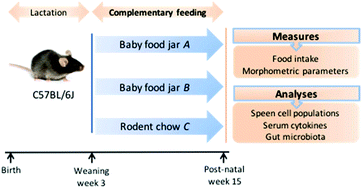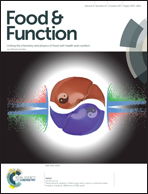Mice gut microbiota programming by using the infant food profile. The effect on growth, gut microbiota and the immune system†
Abstract
During the complementary feeding (CF) period, nutritional imbalances can have negative consequences not only on a child's health in the short term but also later in adulthood, as a phenomenon known as “nutritional programming” takes place. The aim of this study was to evaluate the possible changes in body growth, gut microbiota (GM) and the immune system in mice fed with two different commercial sterilized baby foods in jars (BFJs) for CF. Mice fed with different BFJs (A and B groups) showed an accelerated growth from the fifth week of life when compared with the control (C) group. Group A showed a higher BMI, post-weaning growth rate, and IL-10 levels and a decrease in the Lactobacillus group. Group B showed a significant decrease in the total bacterial count, Lactobacillus group, Enterococcus spp. and Bacteroidetes-Prevotella. The Bifidobacterium genus tended to be lower in groups A and B. Akkermansia muciniphila was more frequently detected in group C. The results obtained from groups A and B can be attributed to the BFJ fatty acid profile, rich in UFAs. This study demonstrates for the first time that the commercial BFJ composition during CF might be a “programming” factor for body growth, GM and the immune system.



 Please wait while we load your content...
Please wait while we load your content...